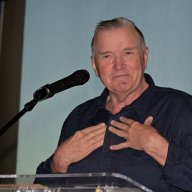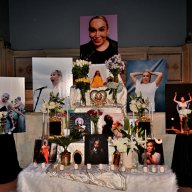Choreographing a trio of dancers, Pam Tanowitz starts collaborating
“I was clueless, so I just did stuff. I did every little showcase. I was just making dances, I had nothing to lose,” Pam Tanowitz said about her arrival, young and naïve from Westchester, in New York City.
That was more than ten years ago. Now, for the choreographer who has a musician husband and a three-year old to think about, the work it takes to put on a show is not so easy. This season, that show is “Love Storyless,” an evening-length trio featuring dancers Anne Lentz, Rashaun Mitchell, and Sally Donaubauer. Created in collaboration with artist Cecily Brown, renowned for her highly energetic oil paintings, the dance incorporates the music of John Adams, which will be performed live by pianist Molly Morkoski, costumes by Yuki Okuyama, and lighting by Carol Mullins.
“This dance took a year. It takes a year to make a good dance,” Tanowitz said, acknowledging all the usual limits, like time and money.
“This is also the first time I’m really collaborating with the dancers,” she added, expressing satisfaction with her growth as an artistic director. “The first time that I let their influence really guide me. I come in with set, specific stuff, but we open it up, invert it, reverse it, use all of our tools. These guys are really thinking dancers.”
A hybrid of ballet and modern dance, Tanowitz’s style deconstructs classical forms, reconfiguring movement with a focus on the tension between beauty and awkwardness. The action of “Love Storyless” will be performed within the space between concave canvass walls produced by Brown that will constrain the normal open area of the Danspace Project sanctuary.
“I think my work looks better in a frame,” Tanowitz said, and the design of the space matches the choreographic content––formal yet awry, asymmetrical but balanced. Tanowitz had not previously been interested in using a set in her work; if anything, she was afraid of it. She was interested in “dance, movement, music, composition.” She hardly ever even reads about anything else. But when the company performed at the American Dance Festival, the program cover featured one of Brown’s paintings, and the idea of painting, its use of layers and textures, grabbed Tanowitz’s imagination.
Brown’s work, like Tanowitz’s, plays with traditional elements. Their approaches are similar and their artistic concerns the same, making for a harmonious aesthetic in the collaboration.
“People use traditional and formal elements to make something new, or they use these same elements to make a comment about or against the traditions,” Tanowitz said. “I like to use leaps and pointed feet and arabesques. My dancers dance. What they do in between, how it’s put together is, I hope, interesting.”
Tanowitz is grateful for her youthful brashness that helped her get to where she is today, as well as for her own staying power––her “addiction,” she calls it.
“In the beginning, you are young and it’s exciting. It’s easy,” Tanowitz said. “As you get older, it’s harder. I’m on my second generation of dancers now––they are in their mid-to-late 20s and I’m in my mid-30s. The people I started with all have different lives now.”
But like so many others who came to New York to dance and to make dances, Pam Tanowitz perseveres, with perspective.
“I used to be stressed out about shows,” she said. “Now that I have a child I know what stress means. Working on a dance or getting ready for a concert is a way for me to release my stress and my imagination, to do something I love.”


































